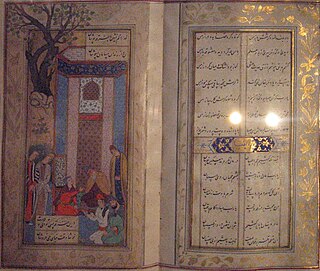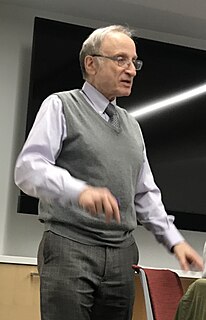Related Research Articles
The genre of Menippean satire is a form of satire, usually in prose, which is characterized by attacking mental attitudes rather than specific individuals or entities. It has been broadly described as a mixture of allegory, picaresque narrative and satirical commentary. Other features found in Menippean satire are different forms of parody and mythological burlesque, a critique of the myths inherited from traditional culture, a rhapsodic nature, a fragmented narrative, the combination of many different targets, and the rapid moving between styles and points of view.
Foreshadowing is a literary device in which a writer gives an advance hint of what is to come later in the story. Foreshadowing often appears at the beginning of a story, or a chapter, and it helps the reader develop expectations about the upcoming events.
The Idiot is a novel by the 19th-century Russian author Fyodor Dostoevsky. It was first published serially in the journal The Russian Messenger in 1868–69.

Mikhail Mikhailovich Bakhtin was a Russian philosopher, literary critic and scholar who worked on literary theory, ethics, and the philosophy of language. His writings, on a variety of subjects, inspired scholars working in a number of different traditions and in disciplines as diverse as literary criticism, history, philosophy, sociology, anthropology and psychology. Although Bakhtin was active in the debates on aesthetics and literature that took place in the Soviet Union in the 1920s, his distinctive position did not become well known until he was rediscovered by Russian scholars in the 1960s.
The term heteroglossia describes the coexistence of distinct varieties within a single "language". The term translates the Russian разноречие [raznorechie: literally, "varied-speechedness"], which was introduced by the Russian literary theorist Mikhail Bakhtin in his 1934 paper Слово в романе [Slovo v romane], published in English as "Discourse in the Novel." For Bakhtin, this diversity of "languages" within a single language is not, in essence, a purely linguistic phenomenon: rather, heteroglossia is a reflection in language of varying ways of evaluating, conceptualizing and experiencing the world. It is the convergence in language or speech of "specific points of view on the world, forms for conceptualizing the world in words, specific world views, each characterized by its own objects, meanings and values."

Self-referential humor, also known as self-reflexive humor or meta humor, is a type of comedic expression that—either directed toward some other subject, or openly directed toward itself—intentionally alludes to the very person who is expressing the humor in a comedic fashion, or to some specific aspect of that same comedic expression. Self-referential humor expressed discreetly and surrealistically is a form of bathos. In general, self-referential humor often uses hypocrisy, oxymoron, or paradox to create a contradictory or otherwise absurd situation that is humorous to the audience.
Intertextuality is the shaping of a text's meaning by another text. It is the interconnection between similar or related works of literature that reflect and influence an audience's interpretation of the text. Intertextuality is the relation between texts that are inflicted by means of quotations and allusion. Intertextual figures include allusion, quotation, calque, plagiarism, translation, pastiche and parody. It is a literary device that creates an 'interrelationship between texts' and generates related understanding in separate works. These references are made to influence the reader and add layers of depth to a text, based on the readers' prior knowledge and understanding. The structure of intertextuality in turn depends on the structure of influence. It is also a literary discourse strategy utilised by writers in novels, poetry, theatre and even in non-written texts. Examples of intertextuality are an author's borrowing and transformation of a prior text and a reader's referencing of one text in reading another.
Carnivalesque is a literary mode that subverts and liberates the assumptions of the dominant style or atmosphere through humor and chaos. It originated as "carnival" in Mikhail Bakhtin's Problems of Dostoevsky's Poetics and was further developed in Rabelais and His World. For Bakhtin, "carnival" is deeply rooted in the human psyche on both the collective and individual level. Though historically complex and varied, it has over time worked out "an entire language of symbolic concretely sensuous forms" which express a unified "carnival sense of the world, permeating all its forms". This language, Bakhtin argues, cannot be adequately verbalized or translated into abstract concepts, but it is amenable to a transposition into an artistic language that resonates with its essential qualities: it can, in other words, be "transposed into the language of literature". Bakhtin calls this transposition the carnivalization of literature. Although he considers a number of literary forms and individual writers, it is Francois Rabelais, the French Renaissance author of Gargantua and Pantagruel, and the 19th century Russian author Fyodor Dostoevsky, that he considers the primary exemplars of carnivalization in literature.
Semiosphere falls under biosemiotics and is an abstract, epiphenomenal, dialogic membrane of semiosis, in which sign processes operate under the set of all interconnected Umwelt.
In literary theory and philosophy of language, the chronotope is how configurations of time and space are represented in language and discourse. The term was taken up by Russian literary scholar M.M. Bakhtin who used it as a central element in his theory of meaning in language and literature. The term itself comes from the Russian xронотоп, which in turn is derived from the Greek χρόνος ('time') and τόπος ('space'); it thus can be literally translated as "time-space."
Logosphere is an adaptation of the concepts biosphere and noosphere: logosphere is derived from the interpretation of words' meanings, conceptualized through an abstract sphere.
In literature, polyphony is a feature of narrative, which includes a diversity of simultaneous points of view and voices. Caryl Emerson describes it as "a decentered authorial stance that grants validity to all voices." The concept was introduced by Mikhail Bakhtin, using a metaphor based on the musical term polyphony.
In literary theory, textuality comprises all of the attributes that distinguish the communicative content under analysis as an object of study. It is associated with structuralism and post-structuralism.

Īhām in Persian, Urdu, Kurdish and Arabic poetry is a literary device in which an author uses a word, or an arrangement of words, that can be read in several ways. Each of the meanings may be logically sound, equally true and intended.

Morton Owen Schapiro is an American economist and the current president of Northwestern University in Evanston, Illinois. Before assuming the Northwestern presidency in 2009, he served as president of Williams College for nine years. Earlier, Schapiro was Dean of the College of Arts and Letters at the University of Southern California. In March 2021, Schapiro announced that he would step down as president of Northwestern University in the following year.

Gary Saul Morson is an American literary critic and Slavist. He is particularly known for his scholarly work on the great Russian novelists Leo Tolstoy and Fyodor Dostoevsky, and the literary theorist Mikhail Bakhtin. Morson is Lawrence B. Dumas Professor of the Arts and Humanities at Northwestern University. He was Chair of the Department of Slavic Languages and Literatures at the University of Pennsylvania for many years prior to leaving for Illinois.
Dialogic pedagogy is a theory and practice of teaching in which dialogue is central. Teachers and students are in an equitable relationship and listen to multiple points of view.
Problems of Dostoevsky's Poetics is a book by the 20th century Russian philosopher and literary theorist Mikhail Bakhtin. It was originally published in 1929 in Leningrad under the title Problems of Dostoevsky's Creative Art but was re-published with significant additions under the new title in 1963 in Moscow. The book was first translated into English in 1973 by R. William Rotsel but this version is now out of print. Caryl Emerson's 1984 translation is the version used for academic discussion in English.
The twentieth century Russian philosopher and literary theorist Mikhail Bakhtin wrote extensively on the concept of dialogue. Although Bakhtin's work took many different directions over the course of his life, dialogue always remained the "master key" to understanding his worldview. Bakhtin described the open-ended dialogue as "the single adequate form for verbally expressing authentic human life". In it "a person participates wholly and throughout his whole life: with his eyes, lips, hands, soul, spirit, with his whole body and deeds. He invests his entire self in discourse, and this discourse enters into the dialogic fabric of human life, into the world symposium."
Caryl Emerson is an American literary critic, slavist and translator. She is best known for her books and scholarly commentaries on the Russian philosopher and literary theorist Mikhail Bakhtin. She has translated some of Bakhtin's most influential works, including Problems of Dostoevsky's Poetics and The Dialogic Imagination: Four Essays by M.M. Bakhtin. Emerson was Professor of Slavic Languages and Literatures and of Comparative Literature at Princeton University from 1988 until her retirement in 2015. From 1980 to 1987 she was a Professor of Russian Literature at Cornell.
References
- ↑ Morson, Gary Saul; Emerson, Caryl (1989). Rethinking Bakhtin: extensions and challenges. Northwestern University Press. pp. 63–. ISBN 978-0-8101-0810-3 . Retrieved 20 April 2013.CS1 maint: discouraged parameter (link)
- ↑ Marina Terkourafi (23 September 2010). The Languages of Global Hip Hop. Continuum International Publishing Group. pp. 234–. ISBN 978-0-8264-3160-8 . Retrieved 20 April 2013.CS1 maint: discouraged parameter (link)
- ↑ Peter I. Barta (2001). Carnivalizing Difference: Bakhtin and the Other. Routledge. pp. 110–. ISBN 978-0-415-26991-9 . Retrieved 20 April 2013.CS1 maint: discouraged parameter (link)